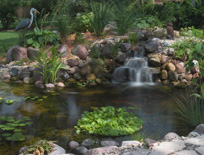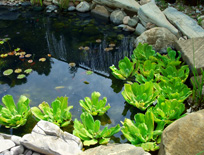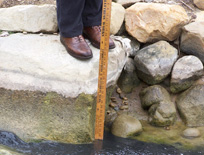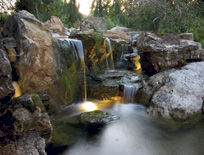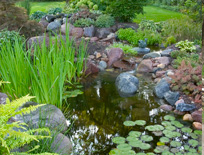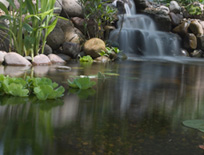Ponds, Streams & Waterfalls
Want to know why creating healthy, low-maintenance ecosystems is so important to contractors who install naturalistic watershapes? It’s because the last thing any of us needs during the busy season is a phone call complaining about
As I peruse my expert-witness files to develop these "Lessons Learned" items, sometimes I run across situations so remarkably silly that I'm reminded why they originally made me scratch my head and marvel at the
Understanding how to move water from one level to another is among the most surprisingly complex challenges in all of watershaping. Indeed, there are lots of ways to get into trouble - even if you're confident that
For the pond-building artist, stone is the paint — and how it is used can make or break the look of a watergarden. Choosing the perfect stone, however, is no guarantee of a beautiful outcome. That’s the realm where creativity and inspiration from
Oddly enough, this story takes place in a down economy and shows how, despite perceived financial limitations, something surprising and wonderful can happen when people put their minds to it. For years now, my work at Aquascape (St. Charles, Ill.) has largely focused on developing, designing and installing systems that in one or more ways are environmentally sound and beneficial. In early 2009, I began working on a plan for a prototype community designed around optimal use of its resources, especially water. I imagined a town filled with rainwater-capturing systems, permeable surfaces and efficient irrigation. It included nothing but indigenous plants, was organized with minimal turf areas and set aside space for composting and cooperative organic farming. As for the homes, all of them boasted various resource- and energy-efficient features. The overall concept was so
Whether you’re installing a small residential watergarden or a large commercial pond, the key to producing one that is both natural-looking and easy to plant is largely determined by how you design
Despite our fondest desires, it’s quite inevitable that most of the things we humans design and build are impermanent and will change. That’s particularly true of the greenery we place in and around our gardens and watershapes, simply because plants grow and gradually alter the settings they surround or inhabit. There’s a measure of melancholy in this evolution: As designers and installers of these spaces, we’re left to recognize that in most cases we will never see them at their best and most beautiful. Yet that’s as it should be, because any living work of art will continue to develop and improve long after it is technically “completed” by our hands. There’s also great joy in creating naturalistic watershapes and garden spaces, because I see the art of finishing as an exercise in setting the table for the future. In fact, I see this as being remarkably empowering: By participating in
In this series of occasional newsletter articles, the staff at Aquascape — a waterfeature design and installation company headquartered in St. Charles, Ill. — will offer information, advice and tips on creating and maintaining quality ponds, streams, waterfalls and pondless waterfeatures. Along the way, the coverage will range from the very basic — the sort of information you can use in training new staff and helping your clients — to the very advanced. To get things started, here's
If there’s one thing all ponds and lakes have in common (beyond the obvious fact that they all contain water), it’s that they’re as different as snowflakes – highly idiosyncratic, often challenging and sometimes almost willful in the way they resist being manipulated. For the past 35 years, we at Diversified Waterscapes (Laguna Niguel, Calif.) have just about seen it all as specialists in maintaining man-made ponds and lakes and in remediating those that have fallen on hard times and suffer with severe problems. We’ve found that every situation is different and that figuring out what’s going on involves the evaluation of countless variables – some obvious and easy to read, others less so. For all that, our experience tells us that the serviceability and sustainability of ponds and lakes is for the most part determined long before we come on the scene – even before they are filled with water. When they’ve been designed and installed with a few key principles in mind, we find them to be cooperative and affordably manageable. If a few of the more common mistakes are made, however, it’s a completely different and far nastier
Last month, we began our discussion of a large pond, stream and waterfall system for a historic upper Midwest estate found on the forested shore of a scenic lake. As related there, the project was to include three major ponds and a series of complex waterfall structures connected by streams rising close to the top of the gently sloping property. To sum up, the space we were working with measured approximately 300 feet wide and 800 feet long – a large section of a 35-acre estate marked by scores of mature trees that largely governed the watershapes’ configurations. Moreover, as there were no natural rock formations or outcroppings on site, we faced the need to










